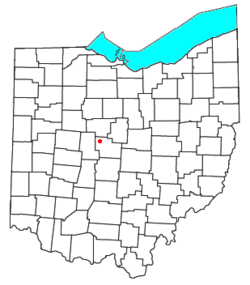Radnor, Ohio facts for kids
Quick facts for kids
Radnor, Ohio
|
|
|---|---|

Location of Radnor in Ohio
|
|
| Country | United States |
| State | Ohio |
| County | Delaware |
| Township | Radnor |
| Area | |
| • Total | 0.72 sq mi (1.87 km2) |
| • Land | 0.72 sq mi (1.87 km2) |
| • Water | 0.00 sq mi (0.00 km2) |
| Elevation | 938 ft (286 m) |
| Population
(2020)
|
|
| • Total | 180 |
| • Density | 249.65/sq mi (96.42/km2) |
| Time zone | UTC-5 (Eastern (EST)) |
| • Summer (DST) | UTC-4 (EDT) |
| ZIP code |
43066
|
| Area code(s) | 740 |
| FIPS code | 39-65298 |
| GNIS feature ID | 2628956 |
Radnor is a small community in Ohio, United States. It's located in Delaware County. It is also called a census-designated place (CDP). This means it's a special area defined by the government for counting people.
In 2020, about 180 people lived in Radnor. The community has its own post office with the ZIP code 43066. Radnor is found along State Route 203, where it meets Radnor Road.
Contents
History of Radnor
Radnor has had a few names over the years. It was first known as New Baltimore. This name was used as early as 1814. Later, in 1833, it was called "Delhi." The name "Radnor" comes from Radnor Township, where the community is located.
Early Settlers and Land
The history of the Radnor area from 1802 to 1825 is closely linked to David Pugh. He was a Welshman from Radnorshire, Wales. David Pugh came to America in 1801 and lived in Baltimore, Maryland, for about a year. There, he met Dr. Samuel Jones, another Welshman. Dr. Jones had received land in Ohio for serving in the Revolutionary War.
In 1798, Dr. Jones bought 4,000 acres of land in what would become Radnor Township. In 1802, he hired David Pugh to explore and survey this land. As payment, surveyors often received some of the land they surveyed. David Pugh received 2,000 acres for his work.
After a two-month journey, David Pugh arrived in Ohio. He set up a temporary base in a settlement called Carpenter. This is now part of Licking County.
David Pugh Buys the Land
David Pugh saw how valuable the land was. In late 1802, he returned to Philadelphia. He offered to buy the 4,000 acres from Dr. Jones. Dr. Jones agreed and sold Pugh 3,505 acres for $2,650. The other 495 acres had already been sold by Dr. Jones to other people. David Pugh was to make sure those people received their land.
David Pugh's land deed was officially recorded in Franklin County, Ohio, on February 23, 1803. In 1808, this land became part of the new Delaware County.
Family and Community Growth
In 1803, David Pugh went back to Wales. He convinced two of his sisters and their husbands to move to America. Because of this, many families in Radnor today can trace their family history back to the Pugh family.
David Pugh did not live in the Radnor area for a long time. He married Jane Murphy around 1808. By 1815, they had moved to a community called Welsh-Hills, near what is now Reynoldsburg, Ohio. They lived there for the rest of their lives.
Pugh divided the 4,000 acres into forty large plots of 100 acres each. He also planned a small village of about 150 acres, which he named New Baltimore.
The First Cabin
Another Welshman, Henry Perry, bought the first 100-acre plot. Henry, his wife Margaret, and their children may have built the very first family cabin in the area. This cabin was likely near the northeast corner of Route 203 and Penry Road. There is still an old well there that people say was Perry's well.
The village of New Baltimore did not grow much. In 1810, Pugh sold the 150 acres of the village to Thomas Morton, Sr., to be used as farmland. By 1825, most of the 40 land plots were being farmed. Radnor Township became a busy farming community.
The name New Baltimore was still used until 1833. That year, Edward Evans surveyed more land and named the village "Delhi." David Pugh still owned some of his original 4,000 acres until 1850. However, he had moved away and was no longer an active part of the community.
Population Information
| Historical population | |||
|---|---|---|---|
| Census | Pop. | %± | |
| 2020 | 180 | — | |
| U.S. Decennial Census | |||
The population of Radnor was counted in the 2020 United States Census. At that time, 180 people lived in the community.
See also
 In Spanish: Radnor (Ohio) para niños
In Spanish: Radnor (Ohio) para niños

